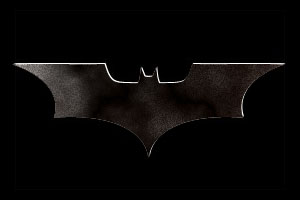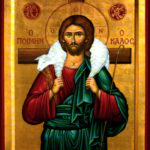Rearranging Icons 2: Defining The Debates
(Make sure to read Fred Warren’s introduction to this new series, about icons in the Bible, history, and speculative stories. This series is based on our ongoing email conversation.)
Good morning, Fred,
This series does seem more ambitious. We might be cheating by basing it on our emails back and forth. Or this might be exactly what we need: the wisdom of Speculative Faith readers, and other contributors, who come from different perspectives and different denominations, and can offer us more — especially about how icons have been used in Church history, and how some have distorted their use, either for them or against them.
 First, I like your working definition of icon, which I’ll adapt, here:
First, I like your working definition of icon, which I’ll adapt, here:
An icon can be a picture, symbol, archetype, stereotype, a graphic container or shorthand for something else. In the Christian tradition, an icon can be a specific kind of devotional image.
That leads me to consider …
Examples of icons
- Picture and/or graphic container for something else. The icons on my computer.
 Symbol. The sign of the bat from Batman. In particular, I recall the film Batman Begins, when Bruce Wayne is returning to Gotham City, determined to start cleaning up the place. “People need dramatic examples to shake them out of apathy, and I can’t do that as Bruce Wayne,” he says. “As a man, I’m flesh and blood — I can be ignored, I can be destroyed. But as a symbol — as a symbol I can be incorruptible. I can be everlasting. … Something elemental, something terrifying.”
Symbol. The sign of the bat from Batman. In particular, I recall the film Batman Begins, when Bruce Wayne is returning to Gotham City, determined to start cleaning up the place. “People need dramatic examples to shake them out of apathy, and I can’t do that as Bruce Wayne,” he says. “As a man, I’m flesh and blood — I can be ignored, I can be destroyed. But as a symbol — as a symbol I can be incorruptible. I can be everlasting. … Something elemental, something terrifying.”- Archetype. These are especially common in stories. They’re the opposite of stereotype, and carry the connotation of a positive, an ideal. I’m thinking of the Sacrificial Hero — an archetype clearly founded by Christ — and others such as the Wise Mentor, or the Damsel in Distress.
- Stereotype. This is where it gets fuzzy, because the above-mentioned Damsel in Distress could also be an archetype. A stereotype may be a negative archetype, like the “shooting up heroine.”
- Specific devotional image. Most people think of “icons” as a Catholic or Eastern Orthodox thing, but really I think Protestants have just as many icons, if not more. I’m thinking about the Cross on a wall or necklace. Or an outline of clasped hands. Or maybe even the old(?) “WWJD?” bracelets.
Like you said before, because we’re not talking about computer graphical-user interfaces, superhero crime-fighting psychology, or even devotional images, we’ll likely want to focus tighter here on the “icons” that relate to fiction and literature.
Icons in fiction
Still, I think the others are more related than we think, or else, should be — such as the symbols, or devotional images. “Embedding” an icon in a work of fiction could strengthen its classic value, or even (to borrow from another Christopher Nolan film) commit “inception” in the subconscious mind of a reader.
You don’t think you noticed the symbol or icon there, but your brain did.
 Sometimes those archetypes are so deep that it takes years to find them. One notable example is Prof. Michael Ward’s theory, which I believe to be valid, that C.S. Lewis, given his literary and mythological background, embedded references to the seven medieval planets in The Chronicles of Narnia, such as theming The Last Battle around Saturn.
Sometimes those archetypes are so deep that it takes years to find them. One notable example is Prof. Michael Ward’s theory, which I believe to be valid, that C.S. Lewis, given his literary and mythological background, embedded references to the seven medieval planets in The Chronicles of Narnia, such as theming The Last Battle around Saturn.
I could get into all kinds of distractions given the relation of mythology and archetypes to Christianity and Christian fiction. So let me instead briefly discuss the issue you raised, about icons in Church history.
Icons in history
You mentioned the icon controversy that was addressed by the Seventh Ecumenical Council in Nicea, in 787 A.D. In this corner were the Iconodules, who defended the use of icons, and in that corner were the Iconoclasts (a more-familiar word that has passed into modern use), who suspected the icons of causing sin.
The Council surveyed the underlying theology issues — about whether the material universe was good or bad, and how Christ’s incarnation with a human body and face and therefore an “image” Himself affected the controversy. Ultimately the Council ruled in favor of the Iconodules, I’ve read, and said that churches could keep the icons, right alongside symbols of the Cross, and the Bible itself. Here’s a quote I found:
“I do not worship matter, but the Creator of matter, who for my sake became material and deigned to dwell in matter, who through matter effected my salvation.”
— St. John of Damascus
One could replace the word “matter” up there with anything else: the church, God’s Word, even stories. We shouldn’t worship those, but they’re also not evil. In fact, I was recently amused to see a Catholic activist, posting on a Protestant ministry’s page, who accused Christians of worshiping Scripture. For “proof,” he presented a theologian’s quote that praised the Bible’s value to society and Christians. My reply: “This is just plain ol’ silly. Or maybe it’s playground revenge for evangelicals who say Catholics ‘worship saints’ or ‘worship Mary.’ Now, take what you guys say in response to that (‘we don’t worship! we just like them a whole lot!’). That’s the answer about the Bible.”
But this does reveal something important: that any icon can be used for good or evil.
If we throw out the un-Biblical Gnostic/Pelagian notions — that it is our corrupted world, and not our evil hearts, that lead us to sin — then we are also forced to throw out objections to all icons — even icons in worship.
Icon critics err in assuming that any visual representation will result in idolatry. They are also inconsistent.
Some may even worship this. But Firefox will crash on you. (Did so for me yesterday.)
A modern example may be a Christian who opposes everything about the Catholic Church, but prizes a certain older Bible translation as the only one that any Christian worth anything should value and adore. That iconicization is at least as bad as people in another denomination who start confusing an image of Jesus with the real Jesus.
Thus, if I start worshiping on icon, I may need to get rid of the icon’s presence in my life. But it’s not the icon’s fault. It’s mine. I have confused the means for the ends. And this would be true for any good gift of God that we abuse.
Speaking of the real Jesus, I believe this discussion will keep returning to that, especially given this time of year. It occurs to me that He, and only He, matches all the aspects of your helpful definition of icon, and I’m sure I can find Scripture that proves every one of those. Christ is the ideal, the exact “image of the invisible God” the Father (Colossians 1:15), the “exact imprint of His nature” (Hebrews 1:3). And yet He is also a Man, a real, flesh-and-blood Man. He’s the only perfect unity of each. So if we think of an “icon” as spiritual and more-abstract, and a “character” as physical and tangible, He is both.










































Taking iconoclasm to its logical conclusion would, of course, be impossible, at least today, when people say anything is art? Can you destroy empty space? Its been used as art. Can you destroy thoughts? Concept artists sometimes consider thoughts art. Can one rid the world of every possible object that may be venerated for its aesthetic appeal.
But on their basic critique of the dangerous allure of beauty, I think the iconclasts were dead right. Art is a kind of religion today, and I have much more respect for fundamentalist iconoclasts, who burn Harry Potter books and call for the banning of Fahrenheit 451, than I have for elitist aesthetes who pay 19.3 million dollars for a Damien Hirst pill cabinet. All the collected art works of humanity are not worth a single human life, yet in the pursuit of standards of aesthetic perfection, human beings have killed millions (Frederic Spotts, for instance, argues that Hitler’s desire to annihalate the Jews was inseparable from his love of the arts, though it was not the only motivating factor). And though I believe that unfortunately there’s no way of logically disproving aesthetic relativism, God himself definitely probably has certain specific aesthetic standards. Using this world’s epistemological standards, we can not prove why the Mona Lisa is more of an artwork than the Holocaust (yes, people argue that the Holocaust can be interpreted as art); yet I still would prefer the fundamentalist formulation of aesthetic theory to that offered by the postmodern art community. The problem is, by giving into absolutist standards of art – for instance, those offered by Francis Schaeffer – one supports the same kind of anti-aesthetic relativism rhetoric that Hitler used to send many modern artists, who were (with the exception of the Futurists) usually anti-fascist, to their death.
Welcome back, John! Thanks for the great comment.
Hmm. Godwin’s Law.
Now for a few thoughts of actual substance:
Then this is not true beauty that has been alluring. True beauty comes from God. Of course, He is very dangerous. But He is also good and loving.
Repeating the point from above: if someone honors, nay worships, even a good thing, if that thing has been separated from worship of God, then the problem is not with the Thing. The problem is with the worshiper. He is in rebellion, pretending that the universe is not what it is and that God is not Who He is.
Similarly:
And yet most pagan religions started with some small piece of truth, separated from the whole of God’s revealed truth (His Word). God Himself instituted art by virtue of His beautiful creation (Genesis 1-2), which even in a fallen world reflects His beauties and truths (the Psalms). He also instituted art by man (Exodus 31 and following), including descriptions of what could arguably be called “icons” in the Tabernacle. The Bible itself contains artful literature — even the straight-up systematic-theology books, like Romans, are works of art. The Bible itself is a work of art, the best and only sure source of truth and beauty, from the master Artist.
All those can be abused. But let’s place blame where it’s due: with the abusers!
I don’t respect either of them, though I increasingly find a love for the not-so-stereotypical “fundamentalists” who reject good books like Harry Potter. I find this love for them, based sometimes on their intentions, but also because I hate to see someone who thinks he/she is adhering to holiness “fundamentals,” but is in fact overlooking many truths of Scripture about stories that are “hidden” in plain sight.
It also seems you’ve identified an example of secular icon-worshiping. And I don’t even know what a “Damien Hirst pill cabinet” is. (Researches.) Oh. That’s not right.
Dear Stephen,
Damien Hirst is a British modern artist who sold a pill cabinet – which is literally what it is, just a cabinet with pills in it, like you could get for thirty dollars from anyone else – for $19 million dollars, because it had his name on it. There is nothing distinguishing it from other pill cabinets. He’s also sold dead sharks bathed in formaldhyde for millions of dollars. A piece of contemporary art that was basically a blank purple canvas (or gold, I can’t remember) sold for millions. Another piece, which was reputed to be a famous contemporary artist’s 30 grams of excrement, sold for about $100,000 dollars (Manzoni, you can google it if you don’t believe me, which I would not blame you). For more established modernists (not contemporary artists), the prices are astronomical. A Picasso sold for $100 million dollars in 2004. At Goldsmiths, according to the documentary But Is it Art (available for free on Youtube), a modern artist at this elite British art school got up in front of her class for her final art project, excreted into a bucket for them, and then left the room.; excretion is apparently a common artistic technique at Goldsmiths, because another artist there, a conceptual artist, excretes the objects she shoplifts and then displays them as art. Yves Klein used empty space as artwork, while the French artist Orlan tapes her own plastic surgery as art. One Central American artist tied a stray dog to a wall at an art museum and starved it to death. The art museum defended it as “art”.
Again, my problem isn’t modern art itself, much of which I like (like being a relative term here). And my problem certainly isn’t the icons of the Orthodox church, which I personally find inspiring. My problem is that art is a narcotic in our culture that, in most cases, distracts us from communal interactions for personal ones, and in almost all cases is not worth the cost of its production. Do we really need another Twilight Novel? Another Stephen King bestseller? Another ponderous piece of Marget Atwood politically correct diatribes? Do I really become a better person from reading Ted Dekker or Chris Walley? Imagine how many poor people we could feed if 1/10 of the money we spent on DVDS or novels or contemporary art was siphoned off into feeding the starving masses of Asia, Africa, and the United States. No, the fundamentalist movement is right; perhaps for the wrong reasons, but still right. The aesthetic realm has become so corrupted by consumerism and cut-throat capitalism that it is not worth salvaging, even if such salvaging was possible at this late date.
In any case, when the last century’s most conceptually original artpiece is a toilet (Marcel Duchamp’s The Fountain, which changed the face of art forever), I don’t think you’re likely to see much of a recovery of the respect for the arts that they “deserve” from the “common man”
Nice to talk to you, Steve.
Oh, yuck, yuck, yuck. I do remember seeing a can of artist’s excrement and rotting bananas squashed behind plexiglass at an art exhibit. I see no need to respect those definitions of art.
One thing I like about writing is that it is creating wealth from nothing but thinking and labor. All of us have to work at something. And all of us consume cultural artifacts. So if by producing a cultural artifact others consume and thereby producing income that is then spent on God’s work, where is the harm? Well, of course I am presupposing that the artifact is not sinful in itself. I buy books and I support missions in Rwanda.
I agree that most of so-called modern art is only attempts to shock a culture that is too weary to be shocked by anything degrading, but that is another topic. As for the issue of “art” versus “ministry” (which I assume you are concerned about, John), it’s too complicated to be an either/or, but should be a both-and.
On a recent trip to England, I visited Westminster Abbey and St. George’s Cathedral at Windsor Castle. They were both beautiful works of architecture, made of beautiful materials, but I did not think of them as wasteful, but rather ways to remind ourselves how small we are compared to the majesty of God. Should such buildings be built today? That is another question, but I do think God can be glorified by buildings as well as ministries.
A couple verses that are now favorites of mine:
“Then bring near to you (A)Aaron your brother, and his sons with him, from among the people of Israel, to serve me as priests—Aaron and Aaron’s sons, (B)Nadab and Abihu, Eleazar and Ithamar. 2 (C)And you shall make holy garments for Aaron your brother, for glory and for beauty. 3 You shall speak to all the (D)skillful, whom I have filled with a spirit of skill, that they make Aaron’s garments to consecrate him for my priesthood.
~Exodus 28:1-3
“You shall weave the coat in checker work of fine linen, and you shall make a turban of fine linen, and you shall make a sash embroidered with needlework.
40 (A)“For Aaron’s sons you shall make coats and sashes and caps. You shall make them (B)for glory and beauty. 41 And you shall put them on Aaron your brother, and on his sons with him, and shall (C)anoint them and ordain them and (D)consecrate them, that they may serve me as priests.
~Exodus 28:39-41
and the fading flower of its glorious beauty,
which is on the head of the rich valley,
will be like (B)a first-ripe fig before the summer:
when someone sees it, he swallows it
as soon as it is in his hand.
5 (C)In that day the Lord of hosts will be a crown of glory,[a]
and a diadem of beauty, to the remnant of his people,
6 and (D)a spirit of justice to him who sits in judgment,
and (E)strength to those who turn back the battle at the gate.
~Isaiah 28:4-6
In other words “because it’s pretty and dignified.”
I do agree there’s a lot of grotesqueness passing for glorious these days, however, the same Jesus who said we’re worth so much more than sparrows and flowers also said the poor will always be with us. (That sound callous. I’m just saying that while, yes, all that money could go elsewhere, I don’t think that “there’s a lot of bad art out there” means “we should just cease creating.” Besides, I’m pretty sure the Communists tried to kill the arts, too, and that didn’t work out so well.)
As far as “icon critics” go, even when they lean too far to the right, they still have plenty more Scripture on their side than someone utilizing an image in worship. God was pretty explicit in “Don’t make any image and call it me.”
As for worshiping Scripture, I think there comes a point where using it as a book of charms might be problematic. Jesus may have refuted the devil’s temptations with Scripture, but he was hardly invoking incantations. They were both quoting the same book.
And on that note, I’m going to conclude with a statement made by a pastor whom I only got to hear once before his passing but whom I will never forget: “See, there’s all this talk about whether Jesus was black or white. But he knew we’d argue, so he went right down the middle.”